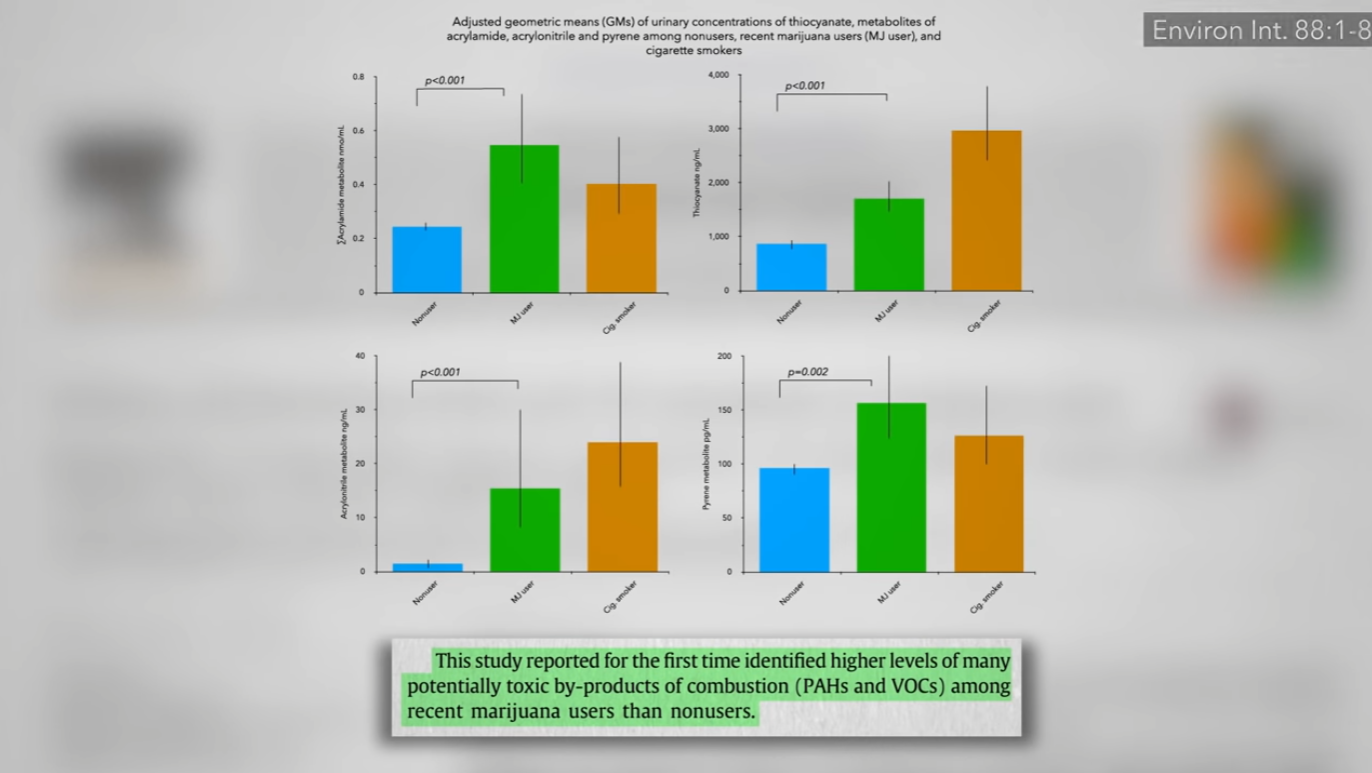
On a puff-by-puff basis, cannabis smoke deposits four times more tar in the lungs than tobacco, but does that translate into increased cancer risk?
Does Marijuana Cause Lung Cancer? As I discuss in my video, “there are at least 33 carcinogens in marijuana smoke,” including polycyclic aromatic hydrocarbons, which are products of combustion. They are found in grilled meat and flow through the bodies of those who smoke marijuana, similar to what flows through the bodies of cigarette smokers, which is really remarkable, as you can see in the graph and at 0:17 in my video. Most tobacco users typically inhale much more smoke into their lungs over the course of a day than do cannabis users, so, on a puff-by-puff basis, is marijuana smoke really that much worse?

Compared to unfiltered cigarette smoke, cannabis smoke does seem to contain more benzopyrene and benzanthracene, which are polycyclic aromatic hydrocarbon procarcinogens. However, cannabis users may just inhale more deeply and then hold in the smoke longer, which can end up depositing four times more tar in the lungs, “amplifying exposure of the lung to the carcinogens within the smoke.” What about bubbling the smoke through water, like in a bong? That does not appear to reduce the risks of tar buildup.
As you can see in the graph and at 1:11 in my video, the tar in marijuana smoke may have similar tumor-promoting effects as cigarette smoke—in mice. But what about in people?

Long-time marijuana users do have more cancers—more lung cancer, oral cancer, and voicebox cancer—but it seems that’s only because they also tend to be more likely to smoke tobacco, too. After cigarettes were taken out of the equation, no increased cancer risk was found.
The same holds for head and neck cancer. One study found increased risk, but five studies reported no association and one study even found decreased risk. “Regular use of marijuana causes airway injury leading to symptoms of chronic bronchitis in some smokers but no…evidence of emphysema,” long-term lung damage. And, despite the carcinogenic components in marijuana smoke, there is no apparent increased risk of lung cancer either. However, “evidence is mixed regarding the risk of heavy, long-term use”—and that may be the crux.
In terms of smoke exposure, smoking a joint every single day for ten years may only translate to six months of pack-a-day cigarette smoking. In most studies on tobacco smoke and lung cancer, six months in a lifetime might even classify you as “a never smoker.” It may take a couple of years of cigarette smoking to significantly bump up lung cancer risk, so that would be like smoking a joint every day of your adult life. It’s no wonder we can’t find a lung cancer link with casual marijuana use. There is also an alternative explanation: Maybe the anti-tumor effects of the cannabis plant counteract the tumor-promoting effects of the carcinogens in the smoke. Anti-tumor effects?
Indeed, the original demonstration of an anticancer effect, dating back to 1975, showed that THC can suppress the growth of lung cancer cells in a petri dish, as you can see in the graph and at 3:10 in my video. These kinds of data have led to wild claims of cancer cures on the internet, “extrapolating the results of preclinical work” (such as in petri dishes and test tubes) “to humans without any basis in fact.” Reportedly, cannabis has not been studied clinically as a treatment for malignancy in people—but that isn’t entirely accurate. A pilot study was performed on terminal brain cancer patients. Find out what they found in Can Cannabis Cure Cancer?.

Doctor’s Note:
Check out Can Cannabis Cure Cancer?, as well as a whole treasure chest of videos on cannabis that I’ve put together. If you want to see them all now, I put them onto a digital DVD.
